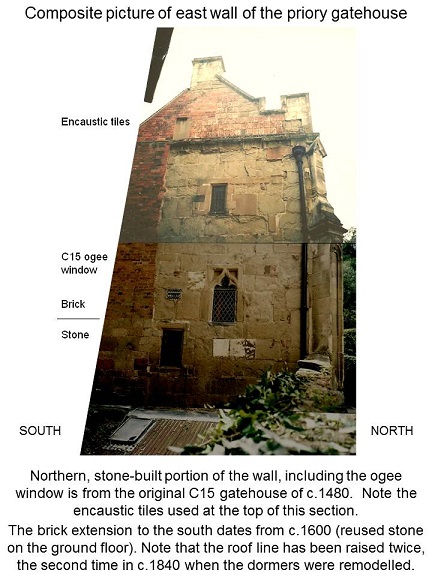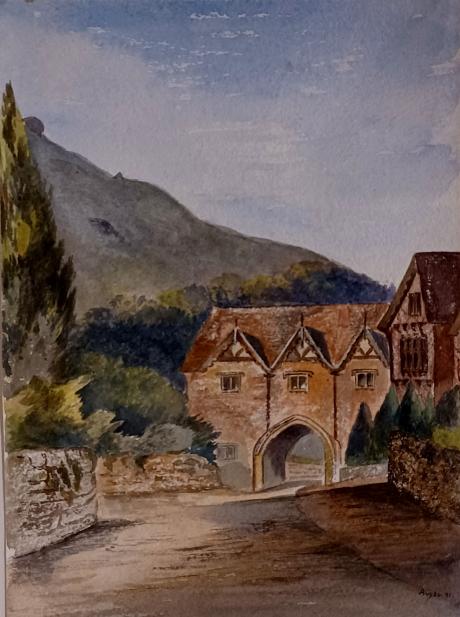inscribed as titke and dated " Aug 30th 1881"
Priory Gatehouse or Abbey Gateway?
The Priory Gatehouse had been the entry point for the Benedictine Priory of Great Malvern for several centuries before the monastery was surrendered to the Crown in 1539. Two hundred years later the building was being referred to as the Abbey Gateway, even though the monastery was a daughter house of Westminster Abbey and as such could never have assumed the title ‘abbey’. The name however has persisted and the building is commonly known as the ‘Abbey Gateway’ or the ‘Abbey Archway’.
A Grade II* listed building and Scheduled Ancient Monument
The gatehouse appears on the National Heritage List for England. This is a list of buildings of historical and architectural importance. It is listed under Planning (Listed Buildings and Conservation Areas) Act 1990 as amended for its special architectural or historic interest. Its list entry is Number: 1349407.
Statistics at this point serve to highlight how important the building is. 92% of listed buildings are Grade II ( 2.5% are Grade I ), but only 5.5% of listed buildings are Grade II* – the Priory Gatehouse is one of these.
Grade II* buildings are particularly important buildings of more than special interest. It was first listed on 30 November 1949 so has been regarded in high esteem for at least 70 years. There was an amendment on 11 May 1979. This was about the time that an ice cream van smashed into the building. It was said the impact carried the building six cm towards Church Street and if you were upstairs you could see daylight between the floorboards.
It is clear that the Priory Gatehouse is a building of national significance.
The gatehouse is also a Scheduled Ancient Monument. We only have 3 in Malvern – the churchyard cross in the Priory churchyard, the moated site at Sherrards Green and the ‘Priory Gateway’. Ours is Monument no. 258 – ‘priory gateway’. Scheduling refers to the process through which nationally important sites and monuments are given legal protection by being placed on a list, or schedule. Historic England takes the lead in identifying sites in England which should be placed on the schedule by the Secretary of State for Culture, Media and Sport. Written consent must always be obtained from Historic England before work on a scheduled monument can begin.
The Priory Gatehouse – its local importance
As its name implies, the gatehouse was the route from the outside to the inside of the monastic enclosure. The earliest datable features of the building date from the late 15th century, perhaps around 1480, with a new stone building possibly replacing an earlier wooden construction.
Under the archway the following original features can still be seen:
- some of the original stone blocks (north of the gateposts),
- ancient and huge oak timbers where the gates were hung (latest research suggests these gateposts date from c.1600),
- the squint window where the porter checked incoming visitors.
In addition there are 64 encaustic tiles at the top of the east wall (similar to those in the priory church). These have been slowly deteriorating over the centuries. Lower down is an ornate window from the original 15th century construction.
At the end of the 16th century the building was extended on the south side. It is easy to see the difference in style and building materials between the 15th and 16th century constructions.
SUMMARY – The building is important because so much of the original building can still be seen.

The Priory Gatehouse – in its National Historical Context
Before the dissolution of the monasteries and other religious establishments, the gatehouse was the barrier between the secular and the religious residents in Great Malvern. Our gatehouse faces north-south – is that unusual? Note that the gatehouses at St Albans Abbey, Battle Abbey and Great Malvern all face north-south. Most medieval gatehouses have been demolished and the building materials reused. Here in Great Malvern we have a rare surviving example of a monastic gatehouse.
After the dissolution most of Great Malvern’s monastic buildings were demolished. The most recent loss was the timber Guesten Hall, demolished about 1840. The Gatehouse by a miracle survived.
SUMMARY – Great Malvern’s Priory Gatehouse is a rare survivor of the country’s built ecclesiastical heritage. It is of national importance to anyone researching monastic architecture and development.
A history of the gatehouse
The medieval fabric of the gatehouse can be best seen under the gateway and in the east wall, shown below. The picture, a composite image, shows the east end of Gatehouse with its Ogee window and encaustic tiles.

The east wall also shows the junction between the medieval work to the north (stone) and the Tudor work to the south (brick). The surviving Tudor structure is best seen in the south elevation.
Gatehouse restoration on the south side

1891 Priory Gatehouse restoration

The north elevation looks medieval, with stonework in the Perpendicular style. However it is a late-Victorian replacement (1891) of the original medieval work.
Mary Keightley (1854-1946) was the youngest daughter of Archibald Keightley (1795-1877), executor of Sir Thomas Lawrence’s estate. She was a good amateur artist. Archibald Keightley (1795-1877), who was a solicitor who was the executor for Sir Thomas Lawrence, who had died earlier in 1830. Mr Keightley was responsible for the sale of Sir Thomas's collections, some of which were not paid for! There is a very interesting story about Sir Thomas's collection of old master drawings which were part of the assets Mr Keightley had to dispose of. Following his work as a solicitor, Mr Keightley a few years later became the Registrar for the Charterhouse School, where he remained for 39 years.
Mary Keightley was born in 1854, in Charterhouse, Middlesex, England, United Kingdom, her father, Archibald Keightley, was 58 and her mother, Sarah Elizabeth Yates, was 41. She lived in London, England for about 20 years and Royal Borough of Kensington and Chelsea, London, England, United Kingdom in 1891. She died on 20 April 1946, in Camberley, Surrey, England, United Kingdom, at the age of 93.

